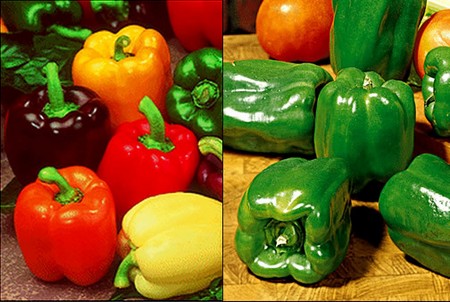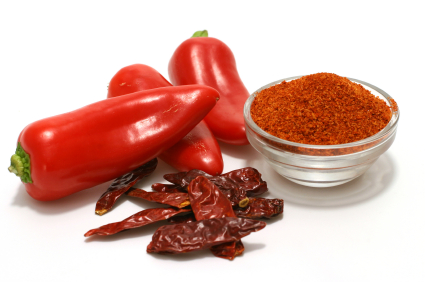The name cayenne or capsicum comes from a Greek word meaning to bite because of the hot pungent taste and properties of cayenne pepper. It is indigenous to Zanzibar, Mexico and South America and now grows in most tropical and subtropical countries. It was apparently discovered by Christopher Columbus when he was searching for a new source of pepper although it is also said to have arrived in the West from India, as the poem suggests, in 1548.
Apart from being vital in the kitchen for peppering up curries, pickles and relishes, cayenne is invaluable as a medicine. In the past it has been used very successfully as a substitute for alcohol to wean ‘hard drinkers’ off their tipple. Cayenne tincture was mixed with that of orange peel and some water and gradually reduced in dose as the craving for alcohol diminished. It was also invaluable for delirium tremens as it reduced the tremor and agitation in a few hours and induced a long, calm sleep. Earlier this century capsicum mixed with salt was famous for curing severe influenza with a putrid sore throat.
Herbal remedy
Cayenne is a powerful stimulant and owes its pungency to the alkaloid capsaicin. It is a major stimulant to the heart and circulation, excellent for warming those prone to feeling cold and with poor circulation, and for warding off winter blues, lethargy and chills. Taken hot at the onset of a cold or fever, it causes sweating and enhances the body’s fight against infection. It has bactericidal properties and is also rich in vitamin C. It has been used as a strengthening tonic and to ward off senility – probably as it encourages circulation to the brain as well as elsewhere in the body.
Cayenne makes an excellent remedy for the lungs. Its pungency that causes eyes to water also increases the secretion of fluid in the bronchial tubes which thins phlegm in the chest and eases its expulsion. It also acts as an expectorant (through reflex action from its stimulating effect in the stomach). As a decongestant in the head and sinuses, it relieves stuffiness and catarrh, and helps to keep the airways clear, thus preventing as well as treating coughs, colds and bronchitis. Recent research in Sweden has indicated that cayenne blocks irritation and broncho-constriction caused by cigarette smoke and other airborne irritants.
In the past, cayenne has been used as a remedy for tiredness, lethargy’, nervous debility and depression. The burning sensation on the tongue that it causes sends messages to the brain to secrete endorphins – natural opiates — which block pain and induce a feeling of wellbeing, sometimes even euphoria. A couple of drops of tincture can be applied to a sore tooth as an instant remedy for toothache. Research has suggested recently that it may ease the pain of shingles and migraine.
In the digestive tract cayenne stimulates digestive tire and enhances the appetite, promotes the secretion of digestive juices and improves digestion and absorption. It can be added to cooking to relieve sluggish digestion, causing wind, nausea, and indigestion, and symptoms caused by ‘cold’ such as diarrhoea, abdominal pain and dysentery.
In South America cayenne has long been eaten to kill intestinal parasites. By warming the digestive tract, the health of the whole person is enhanced: toxins are cleared from the gut, stagnant food wastes are removed and the work of the immune system reinforced. However, if you are prone to overheating or acidity of the stomach, cayenne may aggravate your symptoms, and you should therefore exclude it from your diet.
Recent research has indicated that cayenne reduces the tendency to blood clots and lowers harmful cholesterol by reducing the liver’s production of cholesterol and triglycerides.
In the reproductive system, the warming effects relieve spasm and pain caused by poor circulation and bring on delayed or suppressed periods. It has been used for infertility and as an aphrodisiac, and it is thought to have rejuvenative powers and to delay the ageing process.
Externally, cayenne is a powerful local stimulant and counter-irritant. It is used in ointment, liniments and plasters as a counter-irritant to treat arthritis, muscular pains, neuralgia, bruises and lumbago, and to paint on unbroken chilblains. It helps bring out inflammation and by numbing the skin, relieves pain. Cayenne powder can be placed in woollen socks to warm the feet on cold winter’s days. Use 10—20 drops of cayenne tincture in water to make a good gargle for sore throats and a remedy for colds.
Homeopathic remedy: Capsicum
Capsicum is for weak, debilitated people, lacking vital heat and reactive energy. It acts on the mucous membranes and the bones, and is indicated particularly where there is a tendency to suppuration every time there is an inflammatory process: swollen tonsils become infected, eruptions on the skin become ulcerated, congestion in the middle ear turns to infection.

Physically, the burning effects experienced by eating too much hot pepper are the indications for its homeopathic use — symptoms are characterized by heat and burning, as well as constriction. These may be a red, hot face, hot eruptions on the skin, burning and stinging in the ears, hot feeling in the throat, burning on the tip of the tongue and in the stomach, burning with frequency of urination and heat, and soreness of haemorrhoids and with a bowel movement.
Like the herbal remedy, homeopathic capsicum is prescribed for alcoholics withdrawing from alcohol and for delirium tremens. It helps the enfeebled digestion of alcoholics, and their ‘peppery’ disposition. It is also given for bursting headaches, swelling and pain in and behind the ears, sore throats of smokers and drinkers, herpes on the lips, sore mouths, flatulence, menopausal problems including heavy bleeding with nausea, constriction in the chest with a dry hacking cough and foetid breath, pain in the legs, sciatica aggravated by coughing, and for fever with coldness and shivering, particularly after drinking and in humour.
The symptom picture is characterized then with burning symptoms but a feeling of chilliness. The person has a great sensitivity to cold and damp, especially draughts. It is useful for older people whose vital energy is depleted, especially by mental exertion. They have a great craving for stimulants such as coffee, and a great thirst, and have a peculiar tendency to shiver after drinking.
The flower essence
This wonderful warming plant again enhances fire and energy, and stimulates movement and change in one’s life. The quality of fire is not only warming but also transforming, mobile and creative. It is the fire in the stomach and intestines that transforms food into energy, the light in the eyes, and the spark in the mind. As a flower remedy cayenne is recommended for those who feel stuck in their lives, sluggish, stagnant, and uncreative, not really challenging themselves, caught up in old routines and resistant to change.
Cayenne the flower essence stimulates creative energy and then transforms energy into action. It helps one move decisively into a new phase of life by mobilizing the will and stimulating new motivation. It provides that vital catalytic spark to overcome blocks to transformation.
